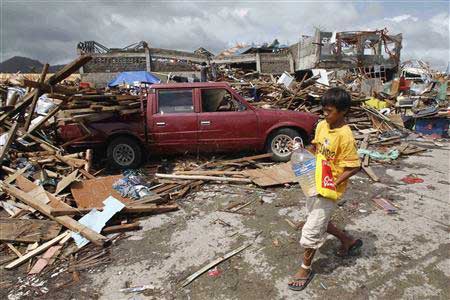U of Michigan prof creates tool for pre-positioning relief goods before PH typhoons hit

Typhoon Haiyan devastation 2013: Efficiently distributing relief supplies to typhoon victims requires storing the goods in the best location even before the typhoon hits. REUTERS
An assistant professor of technology and operations at the University of Michigan Ross School of Business, developed a method to figure out the best placement of relief goods before typhoons hit in the Philippines
In a study recently published in Manufacturing and Service Operations Management, Joline Uichanco, developed a data-driven model for predicting demand for relief distribution ahead of a typhoon.
It allows a government or relief agency to pre-input information and recommendations on the best way to position relief supplies before the storm hits.
Although Uichanco’s work focuses specifically on the Philippines, a similar approach could be to prepare for typhoons and hurricanes around the world, she said.

University of Michigan business school assistant professor Joline Uichanco developed a predictive tool for pre-positioning relief goods before a typhoon hits. UMROSS
In an interview published in the University of Michigan Ross School of Business, Uichanco said she was inspired to develop the tool by the devastating Typhoon Haiyan that hit parts of the Philippines in 2013.
“I was on Facebook, and a lot of my friends and family in the Philippines were saying, ‘Hey, this typhoon is historic; it’s expected to be the strongest typhoon ever in recorded history to make landfall.’”
She saw on international news how people in the hard-hit areas were hungry and thirsty, but, the government and humanitarian organizations “had trouble just delivering food and water.”
Uichangco at the time had just earned her Ph.D. specializing in supply chains, she thought of doing something to help in the Philippines for the future typhoons, especially because it’s an archipelago and ports and supply chains can be easily disrupted.
Pare-positioning relief items before a typhoon is a very important idea “well-recognized by the lead agency in disaster management in the Philippines,” she said.
To pre-position relief goods, really good models are needed for predicting the demand for relief items. “Otherwise, you’ll pre-position in the wrong islands> Poor demand forecasting is the reason why pre-positioning is not done.”
Uichangco studied the public data from Typhoon Haiyan and saw that the government’s ability to distribute relief in the first week after the typhoon faced a lot of limits. “I realized that the optimization model is actually the simple part; the more difficult part is a model to predict demand.”
To predict the demand for relief items in an area, she needed information on its risk vulnerability, such as the population index and its nearness to the typhoon path.
She found that the Philippines actually keeps very detailed daily records about the needs and response activities in all past typhoons — census and housing data, typhoon tracks and wind speeds of past typhoons.The data enabled her to develop a model for predicting demand, from which she created a comprehensive data-driven planning tool for relief pre-positioning.
She said the idea of using data for creating predictions of demand for relief items is something that could apply anywhere, “and that’s something that is lacking in a lot of the humanitarian logistics research.”

